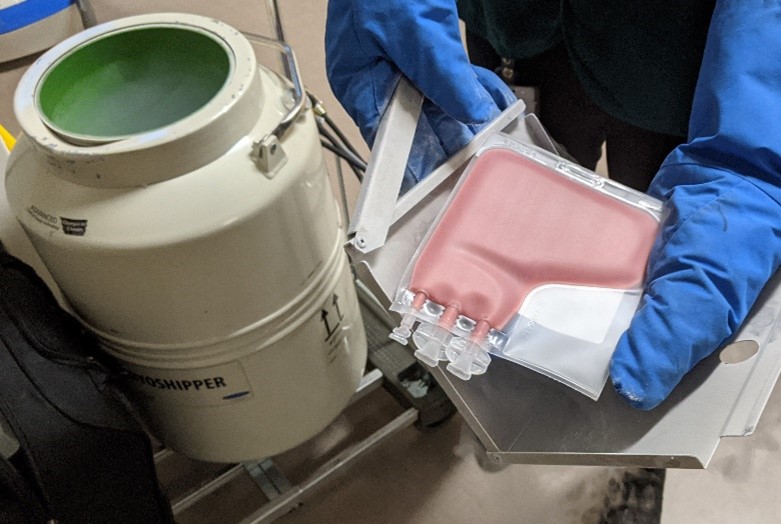The Most Important Project of Your Life!
Two and a half years ago I started working on probably the most important project of my life, and one that benefits me directly as both the project manager and customer. It would utilize over a million dollars in cost, eight months of focus and attention before moving to operations, and a little over a hundred days of intense focus and coordination. Almost two years ago it moved primarily into monitoring and control phase before moving into a closing phase almost 4 months later. It now sits successfully in operations waiting to see if another project will be needed in the future. If we were indeed successful, then no changes or updates should be needed for this project for a long, long time.
This important project is cancer treatment, and the tenants of project management can be used to help treat patients. In October 2020 I was diagnosed with Acute Myeloid Leukemia (AML) and began the journey through initiation, planning, execution, monitoring and control, and closure. During this time, I was amazed at how similar the process was to managing projects. Thinking of it this way helped me organize my thoughts and make decisions as I stepped through the process. For others that undergo diagnosis and treatment, many of the same requirements and processes I had can be adapted for your treatment. Nursing may even want to formalize some of the steps to accomplish successful outcomes in other types of cancer treatment, but also things like trauma care among others.
Initiating
Initiation was probably the most difficult. This was not a planned project, and in fact one that came completely out of the blue. From the time I found out, a plan did begin to develop, however. While there wasn’t a formal project charter per se, there was an agreement on the goals, the high-level requirements to get there, investigation into assumptions, and determination of funding. Almost all the things that make up a project charter are good to put down on paper as an agreement with the patient. It gives them a plan and direction and helps to organize the high-level requirements of caring for cancer. Many of the high-level items here become more granular in detail as exams are done and more information on a diagnosis is gained. It becomes the foundation for the rest of the project.
Another big part of the Initiating Process Group is identifying stakeholders. Some are obvious, the patient as the customer or project owner. They may even be the project manager depending on how much they want to facilitate or be involved in the project. The project manager may also be another family member such as a spouse or parent, or they may be satisfied in letting the Oncologist as their Primary Care Provider facilitate the care and simply keep them informed as a stakeholder. The decision of role should fall to the patient or guardian as much as possible.
Other stakeholders such as nursing staff, family, and friends, and even nurse navigators and case managers. As groups, stakeholders for me included my employer, Insurance companies, Leukemia & Lymphoma Society (www.lls.org), Be the Match (bethematch.org), and Veteran’s Administration among others. Some needed to be simply updated on status, some provided additional information and research I needed to make decisions, and others had options for funding assistance, materials, and even providing of stem cells for the transplant that was planned.
Planning
As you can imagine, the planning part was the most intensive. Things were new, and just like the Project Management Process Group, it has the largest and most significant number of processes. Every single process in this group played a role in planning for treatment, although in the setting of cancer care, the documentation is a little less formal, and many of the details are rolled into patient care plans and progress notes.
A plan is developed, and scope and time management requirements are determined. There is the initial treatment or consolidation chemotherapy with specific medications and times. The work to be done and schedule was laid out on a calendar to follow so I would know where I was at and what was expected at specific steps along the way. Activities were explained and laid out with a specific sequence and duration.
Cost management was laid out by identifying insurance, coverage and requirements. Much of this was reviewed in the context of this diagnosis since many of the resources would be quite costly. Specialty treatments and medications as well as extended hospitalization could easily grow into the tens of thousands of dollars and it was important to know what cost responsibilities would be to plan for financial assistance, or impact on scope of treatment. Nurse case managers as well as contacts at various non-profits could provide additional information on assistance that could be provided in various scenarios.
Project Quality Management, HR Management, Stakeholder Management, and Procurement Management were important areas as well. Daily tests were performed to identify problems or status in order to plan adjust the plan as required. While a patient does not hire the staff and decide on assignments, it was good to know the responsibilities of those staff as stakeholders so that I could pass my own updates as well as request information from the right people along the way. There were many drugs and treatments, some planned as part of the schedule, and some I could request as things progressed and needs were determined.
One of the most important areas is that of Risk Management. There are many areas of risks that had to be identified up front as part of the treatment. Chemotherapy destroyed cells that help the body fight infection and limiting exposure to risks, identifying problems such as a fever or infection, and treating those problems early helped keep things from progressing to dangerous levels. Risks were identified, plans were made to identify anything that occurred, and steps were planned for what to do if risks turned into issues.
Advertisement
[widget id=”custom_html-68″]
Executing
Once the plan was put into place, treatment could begin following the steps laid out. Everybody had their roles in managing that work, and everybody had responsibility to double check quality and treatment. I could perform quality assurance checks by verifying information and asking questions about things that seemed different from the expected routine. Nurses double checked meds and transfusions in some cases to be sure that the steps and procedures were being followed. While some of the questions seemed repetitive, they were a key part of performing quality assurance.
Managing Stakeholders and Stakeholder Engagement helped to not only keep everyone on the same plan and aware of any updates, it helped keep family connected to the process and how things were progressing. Using tools such as Social Media made dissemination of information to family and friends much easier.
The several months and rounds of chemotherapy, transfusions and checks culminated in a Stem Cell Transplant in March of 2021 which was the primary goal in the execution phase.
Monitor and Control

As noted in the Execution and Planning groups above, monitor and control was a major part of the process from start to finish. It occurred during each round of chemo, and during the process of the Stem Cell Transplant itself.
After completing the transplant, some quality assurance took place as an inpatient, and then for several months as an outpatient over the next 100 days. Quality checks became less frequent as lab tests stabilized and as treatments based on those checks also became less frequent. A bone marrow biopsy became one of the final quality assurance tests performed at the transplant facility. Once it was determined that the expected results were obtained, cancer was determined to be in remission. I was able to return home back across the country, to settle back into a more normal routine. Stakeholders were updated, and risks continued to decrease over time. Bills were checked and paid.
Closing
My cancer project was placed into what I would consider “operations” in that routine follow-ups decreased from once or twice a month to every two months or more. Ability to return to work became part of normal operations to the point that I’m back at full-time work. Right now with some modifications, life is returning to normal. Quality checks continue as part of the follow-up and as long as they continue to remain normal, no further significant updates or beginning a new project should be required.
If there are abnormal exams or tests from here on out, they will require beginning a new project like this one with possible changes to scope or processes depending on requirements and advances.
Final Thoughts
Cancer is a difficult process for anyone to go through. With all the things involved in my treatment and care from symptoms because of not only the disease, but the treatments involved, I often thought about how much more difficult it is for kids, as well as those without the experience or resources that I had available to me. Having a well laid out and documented plan helped me organize and elicit the information I needed to be informed as a stakeholder and project manager. My medical background helped me understand the hows and whys of the treatment, and my experience in medical billing has helped me navigate the world of health insurance for a diagnosis as challenging as this.
Incorporating some of the processes in project management can help not only staff, but patients better organize their treatment and expectations. Even if not certified in project management, the knowledge gained by medical staff members can only help patients work through the complex healthcare system for things like cancer, trauma care, and chronic illness.


